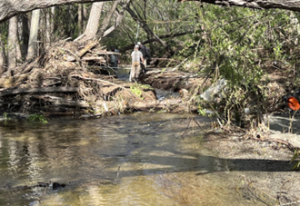Modeling tool developed to predict biological consequences of freshwater salinization

SCCWRP and its partners have developed a modeling tool for predicting how aquatic life becomes increasingly stressed as levels of chloride, sulfate and other ions rise in freshwater ecosystems – a management tool that has the potential to help combat the increased threat of salinization across Southern California and beyond.
The tool, which was released as a web-based app in April, enables managers to generate site-specific insights about how salinization can be expected to degrade biological health for specific segments of wadeable streams. While the tool was initially developed for application in the Santa Ana region, it has the potential to be scaled up for use statewide.
Salinization, which is defined as increased concentrations of ions beyond natural background levels that can harm aquatic life, is becoming a growing management challenge in water bodies statewide – driven by drought, reliance on imported water, and sea level rise. Increased water recycling practices that produce more concentrated brine discharges are expected to exacerbate salinization challenges in the coming years.
Using the salinization modeling tool, both regulated and regulatory managers will be able to identify site-specific ion thresholds aligned to aquatic life protection goals. Already, the study has identified a range of potential ion thresholds that could help combat the adverse biological effects of salinization in wadeable streams.
The Santa Ana Regional Water Quality Control Board asked SCCWRP to take on this project because the existing regulatory thresholds for ion levels in the region’s waterways – originally developed in the 1970s – were not derived to protect aquatic life, but rather to prevent degradation of water quality as a result of increased ion concentrations.
In developing the modeling tool, researchers confirmed that in some cases, existing ion thresholds were set unnecessarily low to protect aquatic life, while in other cases, the thresholds were set too high.
The three-year study also found that ion thresholds should be set on a site-specific basis, with researchers concluding that elevation, rainfall patterns, season and other local factors can create a high degree of variability in natural background levels of ions at different sites.
For example, the study found that low-elevation tributaries tend to have high background levels of ions, while high-elevation headwaters tend to have very low background levels. Meanwhile, summer months tend to have higher background levels than winter months, although season has a much smaller influence on natural levels than other watershed characteristics.
The predictive tool that SCCWRP and its partners developed consists of a pair of models:
- The first model predicts natural background ion levels at a given site, enabling the user to calculate salinization for the site by comparing the modeling predictions to measured ionic concentrations at the site.
- The second model explains how increasing ion levels lead to predictable decreases in biological integrity, as measured by the California Stream Condition Index (CSCI) and Algal Stream Condition Index (ASCI) – two stream scoring tools co-developed by SCCWRP for use statewide.
From the publicly accessible web app, users can visualize background levels and explore a range of thresholds in the Santa Ana watershed.
SCCWRP already has begun working to help water-quality managers in the Santa Ana region interpret modeling predictions and determine appropriate next steps. A technical report summarizing the analyses is expected to be published this summer.
For more information, contact Dr. Raphael Mazor.
More news related to: Bioassessment, Top News